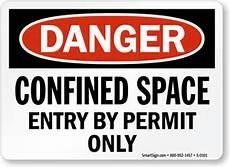Environmental Health & Safety
Confined Space Entry UTK Environmental Health & Safety Program GS-100
The purpose of this program is to ensure that the entry into confined spaces is performed safely and in compliance with OSHA regulations.
Effective Date: 09/15/2009, Revision Date: 07/27/2017
Important Notes
This document is associated with the OSHA Confined Space Standards for General Industry and Construction. Text that is associated with the OSHA Construction standard for Confined Space Entry is emphasized in this document with italicized red font. Please note that we are aware that red text may not be perceived by all. We have italicized this content also to help offset it, however if you require assistance you may contact EHS.
Purpose
To establish a program for safe entry into permit-required confined spaces at the UT Knoxville campus. This program establishes the controls and responsibilities for entering, working in, and exiting permitrequired and non-permit required confined spaces in both general industry settings and in construction environments.
Scope and Applicability
This shall apply to all students, staff and faculty on the UT Knoxville campus who enter and work in any permit-required and non-permit required confined space.
This covers all employees who enter a confined space on campus, such as ducts, tanks, manholes, etc, which may potentially contain hazardous atmospheres or conditions. If employees are engaged in both construction and general industry work in confined spaces the requirements of 29 CFR 1926 Subpart AAConfined Spaces in Construction, must be followed.
Abbreviations and Definitions
Abbreviations
ACGIH: American Conference of Governmental Industrial Hygienists
CRST: Confined Space Rescue Team
LEL: Lower Explosive Limit
PEL: Permissible Exposure Limit
SDS: Safety Data Sheet
TLV: Threshold Limit Value
OSHA: Occupational Safety and Health Administration
UEL: Upper Explosive Limit
Definitions
Authorized Entrants: Individuals who enter the permit-required confined space to perform work.
Authorized Attendants: Individuals stationed outside one or more confined spaces who monitor the authorized entrants.
Barrier: A physical obstruction that blocks or limits access.
Confined Space: An area which: has a size and shape large enough for a person to enter; has limited entrances and exits; is not designed for continuous occupancy. Some examples of confined spaces include: storage tanks; evacuations trenches; boilers; elevator pits; exhaust ducts; sewers; large pipes; dust collectors; utility pits/chases. Confined spaces are classified as either permit-required or nonpermit required.
Competent person: A person who is capable of identifying existing and predictable hazards in the surroundings or working conditions which are unsanitary, hazardous, or dangerous to employees, and who has the authorization to take prompt corrective measures to eliminate them.
Control: means the action taken to reduce the level of any hazard inside a confined space using engineering methods (for example, by ventilation) and then using these methods to maintain the reduced hazard level. Control also refers to the engineering methods used for this purpose. Personal protective equipment (PPE) is not a control.
Controlling contractor: is the employer who has overall responsibility for construction at the worksite. Note: If the controlling contractor owns or manages the property, then it is both the controlling contractor and the host employer.
Entry: The action by which a person passes through an opening into a permit- required confined Space. Entry includes ensuing work activities in that space and is considered to have occurred as soon as any part of the entrant’s body breaks the plane of an opening into the space.
Entry employer: means any employer who decides that the employees it directs will enter a permit space. Note: An employer cannot avoid the duties of the standard merely by refusing to decide whether its employees will enter a permit space, and OSHA will consider the failure to decide to be an implicit decision to allow employees to enter those spaces if they are working in the proximity of the space.
Entry Permit: A written authorization to enter a permit-required confined space. It defines the conditions under which the permit space may be entered. It states the reasons for entering, identifies all hazardous and identifies the entry supervisor.
Hazardous Atmosphere: At atmosphere that may expose employees to the risk of death, is toxic, is flammable or explosive, can results in incapacitation, interfere with an individual’s ability to escape unaided from a space, or cause acute illness.
Host employer: means the employer who owns or manages the property where the construction work is taking place. Note: If the owner of the property on which the construction activity occurs has contracted with an entity for the general management of that property, and has transferred to that entity the information regarding 1) the location(s) of each known permit space; 2) the hazards or potential hazards in each space or the reason it is a permit space; and 3) any precautions that the host employer or any previous controlling contractor or entry employer implemented for the protection of employees in the permit space, OSHA will the contracted management entity as the host employer for as long as that entity manages the property. Otherwise, OSHA will treat the owner of the property as the host employer. In no case will there be more than one host employer.
Isolation: The process by which a permit space is removed from service and completely protected against the release of hazardous energy and material into the space by such means as: blanking or blinding, misaligning or removing sections of lines, pipes, or ducts; a double block and bleed system; lockout/tagout of all sources of energy; or blocking or disconnecting all mechanical linkage.
Permit-Required Confined Space: According to the OSHA standard, this is a confined space and could potentially have one or more of the following hazards:
- Atmospheric Hazards: which can be asphyxiating, toxic, flammable, explosive, or oxygenenriched.
- Engulfment Hazards: which occur when there is the potential to be trapped or enveloped by a dry, bulk granular material such as grains, soil or powdered cement.
- Configuration Hazards: in which the size or shape of the space can trap an individual or make escape or rescue difficult.
- Energy Hazards: which can happen if there is contact with electrical equipment, steam or other sources of energy inside the space.
Non-permit required confined spaces: Confined spaces that do not have, or have the potential to, contain any hazard or hazardous atmosphere capable of causing death or serious physical harm.
Qualified person: means one who, by possession of a recognized degree, certificate, or professional standing, or who by extensive knowledge, training, and experience, has successfully demonstrated his ability to solve or resolve problems relating to the subject matter, the work, or the project.
Roles and Responsibilities
Program Managers (Directors) shall:
- Verify the purpose for each entry into a confined space and issue permits to protect entrants assigned to perform work.
- Ensure that all assigned entrants have current training in the procedures and precautions for work to be performed.
- Inform contractors of the confined space entry program requirements and of the potential hazards of each space to be entered.
- Understand all of the hazards associated with a particular permit-required confined space where work will be performed.
- Verify that rescue services are available and there is a means available to summon them.
- Prohibit any unauthorized individuals from entering the permit-required confined space.
- Ensure that entry operations are maintained consistent with the permit. • Terminate entry and cancel the permit once work is completed
Controlling Contractors shall:
- Obtain information on the location of each permit space; the hazards or potential hazards of the spaces; and any precautions that the Host Employer, previous Controlling Contractor or previous Entry Employer implemented for the protection of employees in the permit space.
- Provide the information received from the Host Employer to each entity who is authorized to enter a permit space, or whose activities could foreseeably result in a hazard in the permit space.
- Provide any additional information or precautions specific to the Host Employer or Controlling Contractor regarding entry into permit spaces.
- Debrief each entity that entered a permit space regarding the permit space program that was followed and any hazards confronted or created in the permit space during entry operations.
- Appraise the Host Employer of any information obtained in its debriefing of entry employers.
Entry Employers shall:
- Implement measures to prevent unauthorized entry into permit spaces.
- Identify and evaluate hazards of permit spaces before its employees enter them.
- Develop and implements the means, procedures and practices necessary for safe permit space entry operations. See 29 CFR 1926.1204(c)(1) through (c)(8) for list.
- Provide, maintain and assure the use of equipment required for safe entry at no cost to the entry employee. See 29 CFR 1926.1204(d)(1) through (d)(9) for list.
- Evaluate conditions inside the permit space and assure they are acceptable before authorizing entry.
- Provide at least one attendant outside the permit space into which entry is authorized for the duration of the entry.
- Designate each employee who will have an active role in entry operations, identify their duties and provide each with the necessary training required in 29 CFR 1926.1207.
- Develop and implement a system for summoning rescue and emergency services, for rescuing entrants from permit spaces, for providing necessary emergency services to rescued employees and from preventing unauthorized persons from attempting rescue.
- Develop and implement a system for the preparation, issuance, use and cancellation of entry permits including both planned and emergency termination as required by 29 CFR 1926.1205.
- Develop and implement procedures to coordinate entry operations in consultation with the Controlling Contractor so that the activities of one employer do not endanger the employees of another employer.
- Develop and implement a procedure for concluding entry operations.
- Review entry operations to identify and correct program deficiencies.
- Review the Permit Space program using cancelled permits that have been retained from the previous 12 month period.
Entry Supervisors shall:
- Coordinate entry operations during a permit required confined space entry.
- Understands the hazards and possible consequences of the planned entry and verifies the permit, procedures and equipment are in place before the entry.
- Determine if a Non-Entry Retrieval system can be utilized during the entry.
- Supervise acceptable entry conditions when entry is planned.
- Authorize entry permit and oversee entry operations and for terminating entry as required by 29 CFR 1910.146.
Confined Space Rescue Team shall:
- Have the capability to reach any victim(s) within an appropriate time frame for the hazards present
- Have the training and ability to administer rescue, first aid and CPR if needed.
All Other Employees shall:
- Have a general understanding or awareness of confined spaces and signage posted.
Confined Space Authorized Entrants shall:
- Know the hazards that may be faced during entry, including information on how hazardous exposure may occur, and the signs, symptoms and severity of overexposure
- Properly use any equipment needed to safely enter the space.
- Sign the confined space entry permit prior to entering the space
- Ensure that air monitoring has been conducted prior to entry and continuously throughout the work.
- Maintain communication with the attendant outside the space, following warnings given by the attendant and exiting the space immediately when told to do so.
- Alert the attendant whenever they recognize any warning sign or symptom of exposure to a dangerous situation, or the entrant detects a prohibited condition.
Confined Space Authorized Attendants shall:
- Know the hazards associated with the confined space.
- Recognize symptoms and health effects if overexposure occurs.
- Order the entrants to evacuate the space if a new hazard or unusual behavior in the entrants is noted.
- Maintain an accurate count of the number of authorized entrants in the space.
- Remain outside the space during entry operations until relieved by another attendant.
- Maintain communications with authorized entrants to monitor their work activities and to alert them if evacuation becomes necessary.
- Call for rescue and other emergency services as soon as the attendant recognizes that the entrants may need assistance to escape from the space.
- Keep unauthorized persons from entering the space or interfering with the entry process.
- Initiate or perform non-entry rescues as outlined in the rescue plan.
- Perform no other activities, which may interfere with the primary job of monitoring the safety and condition of those people inside the confined space.
EHS shall:
- Conduct evaluations of confined spaces on campus, classify and document each as either a permit-required confined space or non-permit required confined space.
- Review and revise the written confined space entry program periodically.
- Develop and conduct confined space training upon request.
- Verify that all entry equipment is maintained and/or calibrated according to the manufacturer’s specifications and the preventive maintenance procedures.
- Offer advisement on the types of person protective equipment that will be required to enter the confined space.
Program Activities
Determining Type of Confine Space
Before any confined space operations begin, the Entry Supervisor or Competent Person will determine if the confined space is permit-required. If there is uncertainty of whether the confined space is permitted, or not, please contact EHS for guidance. If it is a permitted-required confined space, prior to beginning any confined space operations, the supervisor or project manager must develop procedures for the following:
- Summoning rescue and emergency services
- Rescuing entrants from permit spaces
- Providing necessary emergency services for rescue
- Preventing unauthorized personnel from attempting a rescue
Only those individuals who have received confined space training can perform the work in the confined space.
Permit
A permit must be issued for approval before any work can take place in a confined space defined as permit-required. The entry supervisor must document safety measures being taken by completing a Confined Space Entry Permit. Before entry, the supervisor must sign the permit to authorize entry.
The completed permit must be made available at the time of entry to all authorized entrants by posting it at the entry portal or by any other equally effective means; so that the entrants can confirm that preentry preparations have been completed.
The duration of the permit may not exceed the time required to complete the assigned task or job identified on the permit.
A Confined Space Entry Permit at UTK will contain the following information:
- The location of the permit space to be entered.
- The purpose of the entry.
- The date and the authorized duration of the entry permit.
- The name(s) of the authorized entrants working within the permit space.
- The employee(s), by name, currently serving as attendant(s).
- The employee, by name, currently serving as entry supervisor, with a space for the signature or initials of the entry supervisor who originally authorized entry.
- The hazards of the permit space to be entered.
- The measures used to isolate the permit space and to eliminate or control permit space hazards before entry.
- The rescue and emergency services that can be summoned and the means (such as the equipment to use and the numbers to call) for summoning those services.
- The communication procedures used by authorized entrants and attendants to maintain contact during the entry.
- Equipment, such as personal protective equipment, testing equipment, communications equipment, alarm systems, and rescue equipment, to be provided for compliance with this program.
- Any other information whose inclusion is necessary, given the circumstances of the particular confined space, to ensure employee safety.
- Any additional permits, such as for hot work, that have been issued to authorize work in the permit space.
The permit will only cover one 8 hour shift. A new permit will need to be issued if confined space work will extend over one 8 hour shift period. When the work has been completed, the entrant will let the attendant know they are leaving the confined space. The attendant must visibly check and make sure all entrants have left the space and that no tools have been left behind. Pre-Job Preparations
Before any confined space operations can take place, the following procedures must be followed:
- Isolate the permit space: Confined spaces that contain equipment or operations that through the activation of electricity, air, or hydraulics, may injure an employee or cause property damage must be isolated by lock-outs and tags or other positive means of preventing an accident. All involved employees must take part in the lockout/tagout procedures. All electrical and mechanical systems must be tested prior to entry to ensure actual isolation of the systems.
- Purge, inert, flush, or ventilate the permit space as necessary to eliminate or control atmospheric hazards.
- Provide pedestrian, vehicle, or other barriers to prevent unauthorized entry and to prevent objects from falling onto entrants. This may include, but is not limited to, the following methods: set-up cones, post signs, partition-off the area with caution tape, erect barricades, and arrange for traffic control with the UT Police. All permit-required confined spaces will be marked with signs stating:
DANGER
FOLLOW CONFINED SPACE ENTRY
PROCEDURE BEFORE ENTERING
Here is an example of a permit-required confined space sign: (see image).

- Spaces not permanently marked (ex: manholes) shall be posted with a portable sign when access to the spaces are required.
- Confined Space operations involving entry into hot and cold environments may require use of appropriate protective clothing. Consult with EHS prior to selecting any form of personnel protective equipment (PPE), this may include; safety glasses, gloves, chemical resistant suits, hearing protection, etc.
- Equipment used in confined space work operations will only be issued to those employees who are trained in their use. This may include:
- Ventilating equipment needed to obtain acceptable entry conditions.
- Communications equipment necessary to enable the authorized entrant(s) and attendant maintain constant communication and to enable the attendant to summon rescue services without leaving his/her post.
- Personal protective equipment when feasible engineering and work practice controls do not adequately protect employees.
- Lighting equipment needed to enable employees to see well enough to work safely and to exit the space quickly in an emergency.
- Barriers and shields
- Obtain equipment, such as ladders, harnesses and lifelines needed for safe ingress and egress by authorized entrants.
- Obtain rescue and emergency equipment except to the extent that the equipment is provided by or for rescue services.
- Obtain any other equipment necessary for safe entry into and rescue from permit spaces.
Hazard testing before and during entry into confined space
- All confined spaces will be tested by a competent individual before and during entry, using properly calibrated and approved equipment, to evaluate any hazards in the confined space and to verify that the confined space is adequate for entry.
- The air in the confined space will be tested for oxygen levels, flammable gases and vapors, and toxic air contaminants and airborne combustible dusts, which are OSHA mandated. The oxygen levels must be between 19.5-23.5%. The initial air readings must be recorded on the permit and kept at the worksite for the duration of the job.
- If there is the possibility that conditions could change during the entry, continuous air monitoring will be maintained for oxygen, flammable gases and vapors, and toxic substances.
- If work is stopped for any reason, the air tests must be re-taken if deemed necessary by the Entry Supervisor, prior to re-entry.
Eliminating hazards
Mechanical ventilation will be provided when necessary. Follow these guidelines for ventilating confined spaces:
- Begin ventilation in time to assure that the space is safe before entry.
- Test the atmosphere before entry to confirm that the ventilation system is working properly and that the space is safe.
- Continuous ventilation must be maintained throughout the entry.
- If work inside the space can make the air unsafe (e.g., hot work, painting, using solvents, sandblasting, etc.) continue ventilation as long as the work is in progress.
Protective equipment and respirators are to be used only when normal cleaning and ventilating procedures fail to reduce hazards to safe levels.
Rescue
Caution: Confined space attendants shall not enter the confined space for rescue, unless they are qualified for such rescue and a qualified attendant is present to take their place.
As soon as the attendant determines that the entrants may need assistance to escape from the permit space hazards, the attendant shall do the following in the order given:
- Immediately summon rescue services by calling the Knoxville Fire Department at 911 by cell phone, and identifying the site as accurately as possible.
- If possible, attempt a non-entry rescue while rescue/emergency services are en route.
- Using lifeline/mechanical retrieval device(s), extricate the entrant using care to prevent injury or entanglement of the entrant or lifeline within the space. A hoist or other mechanical device for personnel removal will be used for all spaces in excess of five (5) feet in depth. This equipment will be used in situations where it may be difficult to rescue the entrant. If extrication is successful, begin first aid (if trained) as required until relieved by rescuers.
- Upon their arrival, inform rescuers of any known hazards within the space and make available any material safety data sheets pertinent to the rescue.
Rescue and Emergency Services
The primary method of rescue services is provided in-house however; further outside rescue and emergency services may be identified as backup permit space rescue. Rescuers must be able to respond to a rescue summons in a “timely manner” based on the potential hazards of the space.
UT is using the City of Knoxville’s Confined Space Rescue team to perform rescue operations on campus. UT Knoxville is using the City of Knoxville Fire Department for rescue services and the Knoxville Volunteer Rescue Squad for backup services. The non-emergency dispatch number that UT calls to notify the Knoxville Fire Department of Confined Space entry is 215-1154. The Knoxville Fire Department should be notified prior to a scheduled confined space entry. The emergency dispatch number that UT calls for rescue is 911.
The backup agency is the Knoxville Volunteer Rescue Squad. The local emergency service(s) are required to visit the facility to educate them on the hazards they may confront if responding to a rescue situation. Outside rescue services must have the equipment, capability and proficiency to perform the types of rescues that will be required. They must be capable of responding to an emergency or rescue condition in a timely manner and agree to inform the Entry Employer when their services are not available.
Written Permit System
A permit system will be utilized for entry into Permit Spaces. Each canceled entry permit will be retained for at least 1 year to facilitate the review of the permit-required confined space program. Any problems encountered during an entry operation will be noted on the pertinent permit so that appropriate revisions to the permit space program can be made. Coordinating Entry Operations
All outside contractors performing work in confined space entry permit area will be informed of the location of confined spaces, any fire, explosion, health, or other safety hazards of those spaces and any precautions required to control those hazards. This information will be based on an assessment by a competent person and current or past history of the confined space and the nature of the contractor’s work procedure in making such disclosure.
The Program Administrator or other facility representative will inform contractors of plant safety rules and emergency plans which may be applicable to the contractor’s employees. Contractors and their employees must not be allowed to enter a confined space until the provisions of this program have been satisfied. When personnel and contractor personnel are working in or near permit spaces, entry operations must be coordinated to avoid endangering any personnel.
At the conclusion of the entry operations the contractor must be debriefed regarding the permit space program that was followed and concerning any hazards confronted or created in permit spaces during entry operations.
It is the responsibility of each contractor who is retained to perform permit space entry operations to obtain any available information regarding permit space hazards and entry operations from the Program Administrator. They must also coordinate entry operations with the Program Administrator when personnel and contractor personnel will be working in or near a permit spaces. The Program
Administrator must be informed of the permit space program that the contractor will follow and of any hazards confronted or created in permit spaces, either through a debriefing or during the entry operations.
Concluding Entry
The entry supervisor will determine when the entry operations have been completed. The permit space will be closed and the permit canceled. The entry supervisor will write “Permit Canceled” with the date, time, and signature at the bottom of the Confined Space Permit. Other Precautions and Considerations
- If welding, cutting or brazing is to be performed in a confined space, ventilation will be provided. A hot work permit will be completed and attached to the confined space entry permit. (See UTK’s Hot Work Program). Cylinders of compressed gas should never be permitted in a confined space.
- The SDS for any hazardous materials being used in a confined space will be incorporated in the confined space entry permit.
- Ground-fault interrupter-protected or low voltage power equipment shall be used in confined spaces that are conductive (e.g. a metal tank). Portable electrical equipment should be supplied power through a ground fault interrupter or be battery powered, especially when used in wet environments.
- If the confined space contains, or is suspect to contain, combustible gases, employees must use explosion-proof or non-spark producing tools ONLY. No smoking is permitted in a Confined Space or near the entrance/exit area.
- Harnesses, lifelines and lifting equipment may need to be provided, depending upon the depth or height of the confined space. The provided equipment must be made to prevent entanglement. For more guidance on fall protection equipment, please refer to UTK’s Fall Protection program.
Excavations (Trenching and Shoring)
- Some operations such as trenching result in confined spaces. Shoring systems are necessary to protect these spaces and reduce the chance for cave-ins.
- A trench is a narrow excavation below the ground. Trenches are typically deeper than they are wide; however, the width of a trench is less than 15 feet.
- A shoring system consists of a structure that supports the sides of an excavation and is designed to prevent cave-ins.
- Employees must follow all the requirements associated with confined spaces when working within trenches.
Training
The extent of the training depends upon the employee’s involvement with confined space entry activities. Training must be provided to each affected employee to ensure the employee possesses the understanding, knowledge and skills necessary for the safe performance of assigned duties.
When training will be provided to each affected employee:
- Before the employee is first assigned duties.
- Before there is a change in assigned duties.
- Whenever there is a change in permit space operations that presents a hazard about which an employee has not previously been trained or an additional permit space has been identified.
- Whenever the supervisor has reason to believe either that there are deviations from the permit space entry procedures required by 29 CFR 1910.146, 29 CFR 1926.1204 or that there are inadequacies in the employee’s knowledge or use of these procedures.
Three levels of required formal training:
- Awareness training: All individuals performing work and entering areas where there are confined spaces are to be informed of the existence, location, and danger posed by each space via signage or training. All manholes and storm drains are considered to be confined spaces.
- Initial training: Employees working in a confined space must know where this program is located. Employees involved with confined space entry must understand what is required of them and what steps they must take to safely enter a confined space in accordance with this program. Initial training is required before the employee is first assigned duties related to confined space entry.
- Refresher training: Whenever a supervisor has reason to believe either that there are deviations from entry procedures required by this program or that the employee would benefit from a review of the initial training materials (i.e., employee’s knowledge is inadequate).
Pre-Work Review
Prior to executing a permit entry, the entry supervisor, attendant, and entrants must gather together to review the completed Confined Space Entry permit/assessment that pertains to the space being entered.
Specifically, individuals must know:
- What hazards are present
- How the hazards have been eliminated or controlled throughout entry
- What to do if something goes wrong during entry.
When training will be provided to each affected employee:
- Before the employee is first assigned duties under this program.
- Before there is a change in assigned duties.
- Whenever there is a change in permit space operations that presents a hazard about which an employee has not previously been trained.
- Whenever there are deviations from the permit space entry procedures required by this program or that there are inadequacies in the employee’s knowledge or use of these procedures.
Training content shall include:
- Duties of Entry Supervisor, Entrant and Attendants
- UTK’s Confined Space Procedure and other procedures related to confined space entry (i.e. Lockout/Tagout, Hot Work, etc.).
- Hazards of Confined Spaces
- Use of Air Monitoring Equipment
- Use of Ventilation Equipment
- Emergency Action and Rescue Procedures
- Confined Space Entry Equipment, including Personal Protective Equipment.
- Regulatory requirements of 29 CFR 1910.146 Permit Required Confined Spaces.
Documentation of Training
All confined space training, other than awareness training, must be documented. The documentation must include the names of the workers trained, signature or initials of the trainer(s), and the date(s) of training. Training certifications must be available for review by the employees or their authorized representatives. Training rosters shall indicate the employee’s name, date, level of training (i.e. supervisor, entrant and/or attendant) and the instructor who performed the training. Training and Duties of a Confined Space Entry Team
There are three specific members of a confined space entry team. They are authorized entrants, attendants, and entry supervisors; their duties are:
Authorized Entrants (29 CFR 1926.1208)
- Know the hazards that may be faced during entry.
- Recognize the signs and symptoms of hazard exposure.
- Understand the consequences of hazardous exposure.
- Use equipment properly.
- Communicate with the attendant.
- Alert the attendant when warning signs or symptoms of over-exposure are experienced or when a prohibited condition develops.
- Exit the permit space quickly when required.
Attendants (29 CFR 1926.1209)
- Know entry hazards.
- Know behavioral effects of exposure.
- Maintain accurate entrant identification.
- Remain outside the permit space.
- Remains in continuous communication with entrants.
- Monitor entry activities.
- Assesses conditions inside and outside the permit space to determine if conditions remain safe and orders authorized entrants from the space when necessary.
- Summons rescue and emergency services.
- Prevent unauthorized entry.
- Perform non-entry rescue.
- Perform no conflicting duties.
Entry Supervisor (29 CFR 1926.1210)
- Know the potential hazards during entry and work.
- Determine if acceptable entry conditions are present at a permit space where entry is planned.
- Terminate entry.
- Verify that rescue services are readily available and the means for summoning them are operable.
- Remove unauthorized individuals who enter or try to enter the permit space during entry and work.
- Determine that entry and work operations remain consistent with entry permit terms and that acceptable entry conditions are maintained.
- The person authorizing the entry may also serve as the entrant or attendant for the entry.
Training for all employees whose work is regulated by this section must acquire the understanding, knowledge, and skills necessary for the safe performance of the duties assigned.
Training will be provided to each affected employee:
- Before the employee is first assigned duties.
- Before there is a change in assigned duties.
- Whenever there is a change in permit space operations that presents a hazard about which an employee has not previously been trained or an additional permit space has been identified.
- Whenever the supervisor has reason to believe either that there are deviations from the permit space entry procedures required by 29 CFR 1910.146, 29 CFR 1926.1204 or that there are inadequacies in the employee’s knowledge or use of these procedures.
Additional Requirements:
- The training will establish employee proficiency in the duties required by 29 CFR 1910.146 or 29 CFR 1926.1207 and will establish new or revised procedures, as necessary, for compliance with this standard.
- The Program Administrator will certify that the training required by the previously mentioned paragraphs has been accomplished. The certification will contain each employee’s name, the signatures or initials of the trainers, and the dates of training. The certification will be available for inspection by employees and their authorized representatives.
- Only trained attendants, authorized entrants, and personnel authorizing or in charge of entry will work in and around a Permit Space.
Record Keeping
- The Program Administrator will review this program using the canceled permits that were retained within 1 year after each entry and revise the program, as necessary, to ensure that employees participating in entry operations are protected from permit space hazards.
- OSHA Permit Required Confined Space Entry Standard requires that an accurate record be maintained for permitted entries and training. The permits for entries shall be maintained for one year after work has been completed. The Program Administrator will review this program using the canceled permits that were retained within 1 year after each entry and revise the program, as necessary, to ensure that employees participating in entry operations are protected from permit space hazards.
- Records of training that contain the employee name(s), name of trainer and date(s) of training must be maintained for the length of the person’s employment, and be readily available for inspection.
- EHS shall maintain all equipment calibration records for three years.
References
OSHA 29 CFR 1910.146
29 CFR 1910.147, Control of Hazardous Energy
29 CFR 1926 Subpart AA, Confined Spaces in Construction
29 CFR 1910.134, Respiratory Protection
29 CFR 1910.146, Energy Control
29 CFR 1910.132, Personal Protective Equipment (PPE)
Fall Protection
29 CFR 1910.119, Hot Work
Disclaimer
The information provided in these guidelines is designed for educational use only and is not a substitute for specific training or experience.
The University of Tennessee Knoxville and the authors of these guidelines assume no liability for any individual’s use of or reliance upon any material contained or referenced herein. The material contained in these guidelines may not be the most current.
This material may be freely distributed for nonprofit educational use. However, if included in publications, written or electronic, attributions must be made to the author. Commercial use of this material is prohibited without express written permission from the author.
Appendices
Downloadable PDF of entire document
Appendix A: Confined Space Entry Procedure Checklist
Appendix B: Confined Space Hazard Assessment
Appendix C: Confined Space Entry Permit






